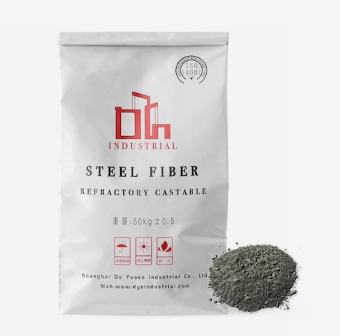How Do You Make Refractory Castable?
Feb 11, 2025Refractory castables are a key component in the construction of high-temperature furnaces, kilns, and other industrial systems. These materials are used in the lining of equipment that must withstand extreme conditions, including high heat, molten metals, and harsh chemical environments. Refractory castables offer a versatile and durable solution for a wide range of applications, from steel making to petrochemical production.
In this article, we will explore the process of making refractory castable, highlighting the steps, materials, and considerations involved in producing this crucial industrial material.
Refractory castables are mixtures of high-temperature-resistant aggregates, binders, and other additives. They can be poured or cast into specific shapes to create durable, heat-resistant linings for furnaces, reactors, and other high-heat equipment. Unlike traditional brick-based refractories, castables offer more flexibility, as they can be molded into complex shapes without the need for intricate cutting or shaping.
The first step in making refractory castables is selecting the right raw materials. The choice of ingredients depends on the desired properties of the final product, such as its thermal stability, chemical resistance, and mechanical strength. The key components typically include:
Aggregates: These are granular materials that provide bulk and structure to the castable. Common aggregates include alumina, silica, magnesia, and bauxite. The type of aggregate chosen depends on the specific temperature and chemical conditions the castable will face.
Binders: Refractory castables require a binder to hold the aggregates together. There are several types of binders, with calcium aluminate cement being the most common. Binders help in forming a strong, cohesive matrix that will harden as the castable cures.
Additives: To improve the performance of the castable, various additives may be used. These can include materials for improving thermal shock resistance, strength, or resistance to slag and molten metal. Chemical stabilizers may also be added to ensure the castable maintains its integrity under high temperatures.
Water: Water is used to mix the components and activate the binder. The amount of water added is crucial, as too much or too little can affect the workability and final properties of the castable.
Once the raw materials have been selected, they are carefully mixed to create a homogenous mixture. The aggregates, binders, and additives are blended together in a controlled environment to ensure uniformity. The mixing process is critical, as uneven distribution of materials can result in defects or weak spots in the final castable.
During mixing, water is gradually added to activate the binder and to achieve the desired consistency. The amount of water is controlled to prevent the mixture from becoming too runny or too dry. The goal is to achieve a workable, dough-like consistency that can be easily poured or molded into the desired shapes.
After the materials are thoroughly mixed, the refractory castable is ready to be cast into molds. Depending on the application, castables can be poured into pre-formed molds or applied directly to the surface to form a lining. In some cases, castables may be pumped or poured into a mold and then shaped to fit the contours of the equipment they are intended to line.
This step may also involve vibration or tapping to remove any air pockets that could weaken the castable. Ensuring that the castable is free from air pockets is essential to maintaining its strength and durability when subjected to high temperatures.
Once the castable is poured into the mold, it must be left to cure. Curing is a crucial step in the process, as it allows the binder to fully react and harden, creating a strong, cohesive material. The curing time and conditions depend on the specific binder used, but it typically involves letting the castable dry in a controlled environment for several hours or even days.
After the initial curing period, the castable may need to be slowly heated in a process known as drying out. This process gradually increases the temperature to remove any remaining moisture. Drying is important to ensure that no water remains in the castable before it is subjected to high heat in its final application.
After curing and drying, the refractory castable is ready for its final heat treatment. This is typically done in a furnace, where the castable is gradually heated to its intended operating temperature. The firing process helps to further solidify the castable and ensures that it can withstand the extreme conditions it will face in service.
The firing temperature and duration depend on the specific materials used and the type of refractory castable being produced. In general, firing temperatures can range from 800°C to over 1,500°C, depending on the application.
Once the refractory castable has been fired, it undergoes rigorous testing and inspection to ensure it meets the required specifications. This may include testing for compressive strength, thermal shock resistance, porosity, and other key properties. The castable may also be examined for any defects, such as cracks, air pockets, or uneven surfaces, which could affect its performance in service.
Making refractory castable is a precise process that requires careful selection of raw materials, controlled mixing, molding, curing, and firing. By following these steps, manufacturers can produce high-quality refractory castables that meet the demanding needs of industries requiring heat-resistant materials, such as steel production, ceramics, and petrochemical manufacturing.
At DYSen, we specialize in providing durable, high-performance refractory materials, including castables, to industries worldwide. Our commitment to quality and service ensures that your operations run smoothly and efficiently, even in the harshest environments.